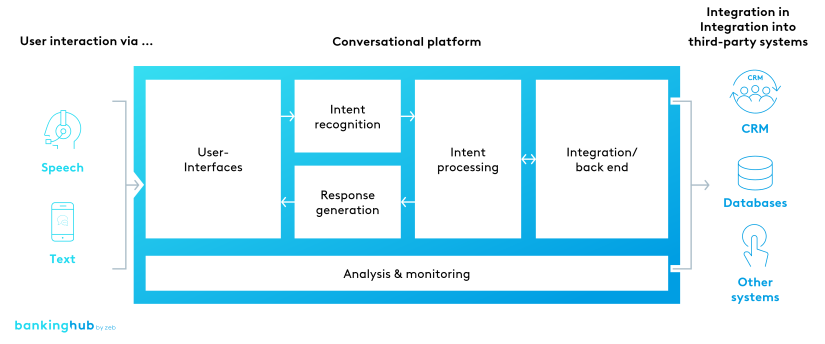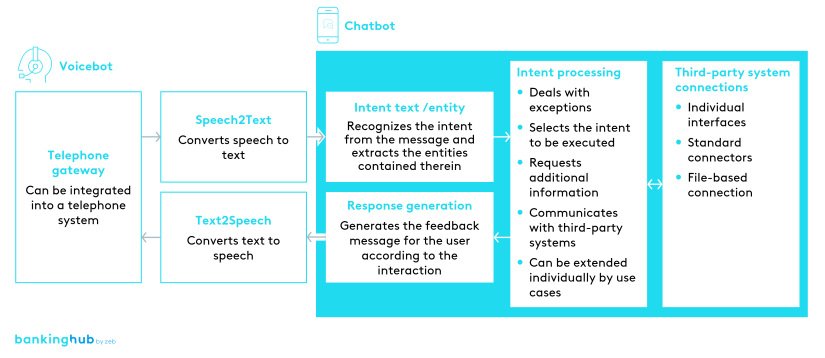|
LISTEN TO AUDIO VERSION:
|
Optimize chatbots and voicebots with AI
The chatbots and voicebots underlying technology was simply a predefined conversation in which the bot asked customers a selection of questions or provided responses on specific topics. It was impossible to deviate from the defined standard in the examples mentioned at the beginning.
What makes this topic increasingly interesting is the advancing technology, where chatbots and voicebots are operated with the help of artificial intelligence (AI for short). AI technology allows the bot to act much more flexibly and at times to even formulate answers on its own. Regular use of the bots continuously optimizes the so-called natural language understanding function, thereby enabling the bot to operate more and more effectively.
This development is summarized by the term conversational artificial intelligence (conversational AI for short). Compared to the first generation, bots can now be used in a wide variety of ways, making them a strategic asset for financial services providers.
Conversational AI: Automated customer dialog
The main idea of conversational AI is to establish dialogs between man and machine, in which the machine emulates human communication behavior as closely as possible. The user interacts with the so-called conversational platform via voice or text.
AI recognizes the intent of the user’s request and then extracts the essential content. This automatically triggers a use case (or intent processing, as depicted in the diagram). A flexible conversation flow is now defined in a use case, into which the user is integrated. At the same time, third-party systems are connected for querying or changing information and for triggering further processes.
Advantage of a conversational AI platform is the uniform connection to different channels
A modular design of the conversational platform, which always accesses the same “knowledge” base, significantly reduces the effort required to maintain different channels, for example, when using separate chatbot and voicebot solutions. If individual processes need to be modified, for example to meet regulatory requirements, this only needs to be done once centrally for all channels.
This approach not only reduces effort but also ensures that the customer receives the same information or is led through the same processes regardless of the channel.[1]
In addition to actually conducting conversations, a central component of conversational AI is continuous learning from conversations that have already taken place. This form of AI is used to analyze the probabilities of intent recognition, for example, and to retrain those cases in which the bot has only achieved a low hit rate (technical term: confidence level).
In addition to analysis, monitoring is also important. Machine communication, for instance, must include options for continuing the conversation with a real person.
Core components of chatbots and voicebots
Voicebots are chatbots extended by spoken language (voice). Both bots use the same technologies for intent recognition, processing and generation.
Using and processing spoken language, however, requires additional components. A so-called telephone gateway is required to integrate the bot into a telephone system. The spoken language transmitted via the telephone is subsequently converted into text, then analyzed and further processed. The bot’s response is converted from text to speech accordingly, so that it can be output over the phone.
Natural language processing (NLP) for chatbots and voicebots
The components and technologies used in both voicebots and chatbots fall within the scope of natural language processing (NLP for short).
Natural language refers to the language used in everyday life, which is complex, has only a limited set of clear rules and offers an infinite number of phrasing possibilities. As chatbots and voicebots evolve from defined to free communication, natural language processing makes all the difference.
Natural language understanding (NLU) for chatbots and voicebots
Intent recognition is based on natural language understanding (NLU for short), a sub-discipline of NLP.
For this purpose, the text is analyzed in order to detect the user intent and to extract information (so-called entities). This is clearly illustrated by the following example: “I would like to book a train to Munich”. The bot must understand that the user wants to book a train, not a flight, and that “book train” means booking a train ticket. In addition, the information “to Munich” must be included and assigned to the “destination” entity .
Once the intent has been detected, it is processed in the next step. This processing can take several forms. In the example, the first processing step would include the completion of entities such as “starting location”, “date”, “time”. Subsequently, the system could communicate with third-party systems, for instance, to search for suitable trains or book the train ticket and store it in the systems.
Depending on how the intent is processed, it may be necessary to generate responses, request additional information or communicate information or results.
Natural language generation (NLG) for chatbots and voicebots
Generating a response falls in the domain of natural language generation (NLG for short).
In this case, the bot generates a text in natural language with the aim of conveying the information in a meaningful way so that the user understands it.
The connection of chatbots and voicebots to the third-party systems can be designed very flexibly. It is possible to create and use individual interfaces for targeted forwarding and processing, to connect standard interfaces or to use a file-based connection.
By connecting third-party systems, chatbots and voicebots can be integrated into processes in a fully automated manner, thus generating real added value.
What is the future of chatbots and voicebots?
There is no doubt that these new technologies represent a very strong use case for the financial services industry, and that the technologies are undergoing major leaps in development. It is essential that we direct our focus towards them and to set the right course so as to ensure that we can rely on these technologies in the future. This includes not only the creation of appropriate governance, but also the consideration of various success factors.
In sum, we agree: the digital assistant will also be playing an important role in personal interaction with the bank or insurance company.












